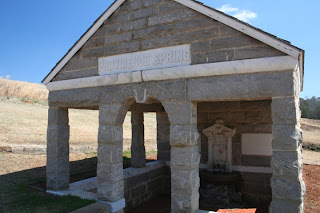Our visit to Andersonville National Historic Site today was a real education in American history and one which we seldom hear about.
 |
| National POW Museum |
Andersonville, Georgia was the site of a Confederate prisoner of war camp. This camp was constructed late in the war (1864) after Washington banned the practice of prisoner exchange. Built for an occupancy of about 6,000, but during the short time it was open before the end of the war, the population quickly grew to more than 30,000 at one point. More than 45,000 Union soldiers came through the camp, but due to overcrowding, shortage of food, lack of water, and unsanitary living conditions some 13,000 died.
 |
| North Gate. Every prisoner entered through here |
 |
| Each prisoner was responsible for making his own shelter |
Andersonville was selected because it was far from the fighting and was near a railroad line. A more secure place than where most of the camps were located near Richmond. This particular area also had a stream running through what became the center of camp. This small stream was woefully inadequate for the thousands who depended on it for their only water source. The stream is still running through the middle of the camp and it is hard to imagine why anyone would have thought it adequate even for 6,000 men much less 30,000.
Today, the 26 acres which comprised the area of the camp is preserved by the park service. We toured the area, stopping at the various points along the route to contemplate what the lives of these poor men would have been like. It is impossible to imagine.
 |
| Statue at entrance to the cemetery |
We also toured the cemetery. When the camp was in operation, prisoners died so rapidly there was not enough manpower to keep up with individual graves. The dead were buried in trenches and marked with a stick which identified the fallen by their number. Later, the sticks were removed and small wooden crosses were put in their place. Still later, the crosses were removed and stone markers were placed to honor the brave men who died imprisoned at Andersonville. This is a National Cemetery and soldiers of other wars are also buried here. In fact, we saw a fresh grave today.
We started our visit at the National Prisoner of War Museum. We saw two very sobering and thought provoking films--one on Camp Sumter, the original name of the Andersonville camp, and one on prisoners of war in general and the ordeal they endure. The museum is very well done and outlines the life of a POW from capture to release.
How can we adequately express our gratitude to those men and women who have and do serve their country?




No comments:
Post a Comment